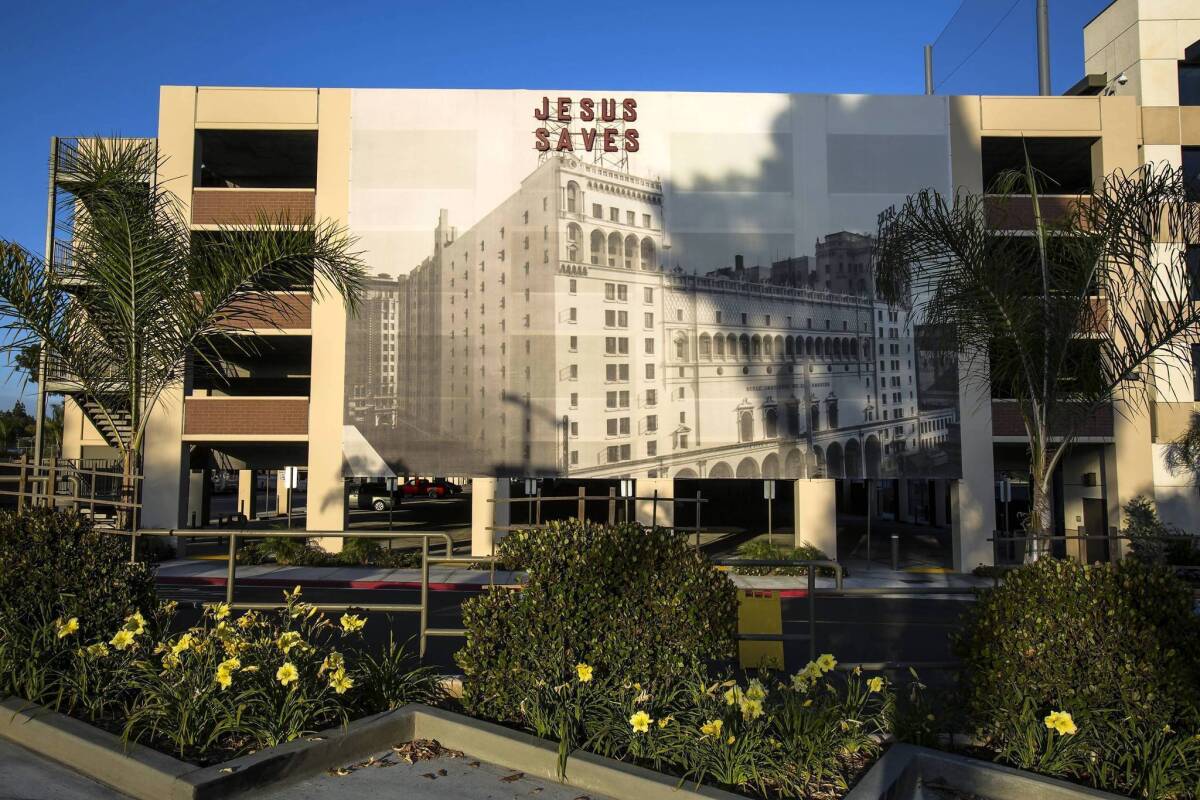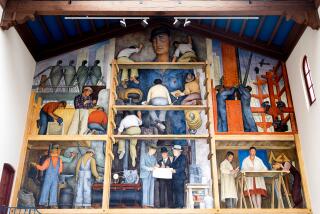Biola University settles for replica of iconic ‘Jesus saves’ sign

- Share via
Saving the iconic “Jesus saves” sign was one thing, but resurrecting it was another matter.
So Biola University has come up with a creative replica of one of the eye-catching signs that once towered over the Bible Institute of Los Angeles’ downtown headquarters.
The original bright red, 7-foot-tall neon letters were placed on the institute’s dormitory roofs in 1935 and 1937 and glowed until 1988, when the building at Hope and 6th streets was torn down.
The evangelical signs sat abandoned in a scrap yard alongside the Pasadena Freeway until flamboyant television minister Gene Scott purchased the historic United Artists Theatre on Broadway and turned it into what he called University Cathedral. He acquired the two signs and had them installed on the old downtown theater’s roof.
Scott died eight years ago, and in 2011 his widow, Melissa Scott, moved one of the signs to Glendale, where she is pastor of Faith Center Church. The other sign remained on the Broadway building, which is now being converted into a high-end Ace Hotel.
Biola officials said they hoped to buy the signs and move them to their La Mirada campus and were dismayed when their efforts were unsuccessful.
“The developer behind the hotel thought the sign was pretty cool and that it could coexist with the boutique hotel they were building,” said Brian Shook, a university administrative director. “They wanted to keep it.”
Then the university approached Melissa Scott for her “Jesus saves” sign.
“She seemed open to the idea, but we never heard back from her. We finally just gave up,” Shook said.
Biola President Barry H. Corey decided that a replica “Jesus saves” sign would create “a fitting reminder” that the school’s core values have not changed in the 105 years since the school’s founding. The Bible Institute of Los Angeles eventually shortened its name to Biola and moved from downtown to La Mirada in 1959.
The sign, one-third the scale of the originals, is incorporated into a 38-by-59-foot photographic mural of the original Bible Institute building and displayed on the side of a parking structure in the interior of the university’s 95-acre campus.
“The placement and size needed to abide by our city’s codes and requirements, including height limitations and sightlines that restricted visibility to our campus boundaries,” Corey said.
City restrictions also blocked the use of neon in the replica sign, so LED bulbs are used instead.
The mixed-media approach was recommended by the university’s internal public art committee, which concluded that such an installation would serve as both an art piece and a historical marker.
The creation and installation of the sign and mural cost about $25,000. It was partially funded by Biola’s 2013 graduating class.
Ace Hotel Group officials in New York could not be reached for comment about plans for their “Jesus saves” sign. A representative of the firm said the boutique hotel chain is known for the individual artwork and decor in the rooms.
Melissa Scott did not respond to a phone inquiry, and a security guard at the Faith Center on Glendale Avenue turned away a reporter seeking information about her “Jesus saves” sign. The sign was not visible on church property, although a large object near TV satellite dishes at the rear of the center was covered with a dark tarp.
Corey said Biola remains interested in eventually reclaiming its iconic signage.
“If, somehow in the future, one of the original large neon signs were to come into our possession, we would need to explore with the city of La Mirada where and how to display it,” he said.
Biola students said that getting the originals back would be nice, but the replica — switched on for the first time May 24 — is a unique link to the school’s past. Several indicated they wish the sign were more visible to the public.
“I definitely think it’s nice, even if it’s not the real thing,” said Ashleigh Fox, 20, a junior majoring in journalism. “If they get the original one, they should put it where somebody can see it. This one is a little hidden.”
Senior psychology major Brett Kibold, 21, agreed.
“It’s really awesome. To be honest, I kind of wish it was more visible to the public. But the city didn’t want anything that would distract drivers.”
More to Read
Sign up for Essential California
The most important California stories and recommendations in your inbox every morning.
You may occasionally receive promotional content from the Los Angeles Times.










